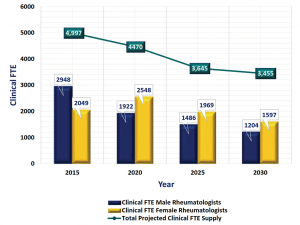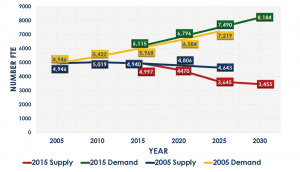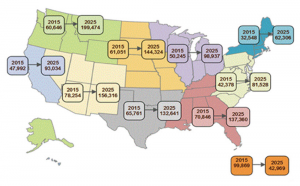
(click for larger image)
Figure 1: Projected Decline of U.S. Rheumatologists
Source: 2016 ACR/ARHP Annual Meeting, Abstract 89,
Figures: Seetha Monrad
Ten years have elapsed since the ACR conducted its last workforce study, and we know that much has changed. The comprehensive patient-centered, integrative approach to the 2015 ACR/ARHP Workforce Study of Rheumatology Specialists in the United States (now publicly available) describes the character and composition of the current clinical workforce, recognizes demographic and employment trends, informs workforce and succession planning for the ACR/ARHP, and projects future supply and demand estimates based on best- and worst-case scenarios.
When you review the study results, you’ll find that although the broad trends are akin to the findings of the 2005 ACR Workforce Study, the size of the gap between rheumatology provider supply and patient demands is much wider than expected.
The Results in Brief
In fact, the 2015 Workforce Study paints a startling picture of the rheumatology workforce in the next 10 years. It projects a shortage of 3,845 rheumatologists in the U.S. by 2025, an increase from the 2005 ACR Workforce Study, which projected a shortage of 2,576 rheumatologists. A declining rheumatology workforce resulting from significant baby boomer retirements (among both patients and rheumatologists), millennial ascendency and a gender shift toward women will be met with an increasing patient demand.

(click for larger image)
Figure 2: Demand Outstrips Supply
Source: 2016 ACR/ARHP Annual Meeting, Abstract 93
Figures: Seetha Monrad
We also anticipate a significant increase in the prevalence of doctor-diagnosed arthritis in the next 20–25 years. By 2030, an estimated 67 million adults (25% of the projected total adult population) aged 18 years and older will have doctor-diagnosed arthritis. This aging population is anticipated to increase the number of adults suffering from osteoarthritis, and other age-related conditions will be a contributor to an increased demand for rheumatologists over the coming decades.
Unfortunately, a regional maldistribution of rheumatologists in the U.S. exists, and disparities will continue to increase with anticipated retirements and regional population growth estimates, particularly in the South Central, North Central and Northwest regions. The estimated total number of adult rheumatologists in the U.S. workforce in 2015 by full-time equivalent (FTE) is 4,997, with a projected decrease to 3,645 by 2025 (see Figures 1 & 2). The overall adult-to-physician ratio is projected to be 99,177 by 2025 (see Figure 3).
Challenges Ahead

(click for larger image)
Figure 3: Projected Increase in the Number of People per Rheumatologist (2015–2025)
Source: 2016 ACR/ARHP Annual Meeting, Abstract 928


